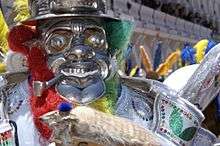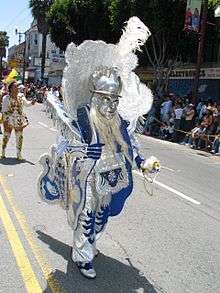Morenada
| Morenada | |
|---|---|
| Cultural origins | African and Native American communities in Bolivia |
| Typical instruments | Matraca, cymbal, bass drum, trumpet, tuba. |
| Other topics | |
 | |
| Part of a series on the |
| Culture of Bolivia |
|---|
 |
| History |
| People |
|
|
Festivals |
|
Art
|
|
|
Music and performing arts |
|
|
Monuments
|
|
Symbols |
|
The Morenada (Dance of the Black Slaves)[1] is a music and dance style from the Bolivian Andes characterized by a mixture of African and Indigenous elements.[2] The origins of this dance are debated among specialists on this topic, the three main hypotheses say that the dance could have been inspired in African slaves brought to Bolivia to work in the silver mines of Potosí, another theory states that it would be inspired in the Afro-Bolivian community living in the Yungas region of La Paz, and the third main theory links this dance with the Aymara culture due to the findings of cave paintings in the Lake Titicaca shores in the Taraco peninsula.[3]
In June 2011, through a Supreme Decree the Morenada was declared Intangible Cultural Heritage of the Plurinational State of Bolivia, according to the government, this measure was taken to stop the attempts of appropriation by neighbor countries.
On August 4, 2013, a historic event took place called "100% Bolivian Morenada: for world peace and Bolivian Culture Respect", in which hundreds of thousands of people danced in 76 cities in 23 countries worldwide, Bolivia, Germany, Argentina, Austria, Brazil, Canada, Chile, Ecuador, Spain, United States, Finland, France, Holland, England, Italy, Japan, Mexico, Norway, Panama, Sweden, Switzerland and Venezuela. This event was organized by the OBDEFO (Bolivian Defence Organisation and Dissemination of Folklore) in order to show the world that dance is purely Bolivian.
Origins
There are several theories about its origins which are fiercely debated among the specialists in this topic. Basically there are three hypothesis:
African slavery in Potosí theory

The most commonly shared theory says that the dance was inspired by the sufferings of the African slaves brought to Bolivia in order to work in the Silver Mines of Potosí. The enormous tongue of the dark masks is meant to represent the physical state of these mines workers and the rattling of the Matracas are frequently associated with the rattling of the slaves' chains. However, there is no evidence that these African slaves actually worked in the mines, although there is much evidence that they worked in the Casa de la Moneda (mint) in the production of coins and in domestic service.[3]
Afro-Bolivian community in Yungas theory

A second theory relates the Morenada to the Afro Bolivians living in the Yungas region and the stamping of grapes for wine production. According to this, the barrel-like Moreno-costumes would represent the barrel containing the wine. However, in the Yungas region there has never been any wine cultivation. At first sight this makes the theory seem extremely unprovable, but the texts sung in the Morenada contain hints as to wine cultivation for a long time. In addition, if one goes far enough back in history, one can discover that there were Afro-Bolivians working in vineyards - in other regions, such as Chuquisaca. Nowadays there might not be any Afro-Bolivians left where there are wineyards, but when the dance was created, there might have been.[3]
Cave paintings in the Lake Titicaca theory

The third theory relates the Morenada to the Aymara Culture of the Lake Titicaca. Places such as Achacachi claim to be the place of origin of the "Fish Dance", as the Morenada in this region also is called. Some murals about 200–300 years old were found in the region, showing Morenada dancers and there still is a strong tradition of making elaborately embroidered Morenada costumes. The multicolored costumes of the Morenada are somewhat similar to the ones of Tinku dancers.[3]
Characteristic
Notes
- ↑ Alan Murphy; Roger Perkins; Kate Hannay (1 July 2002). Bolivia Handbook. Footprint Travel Guides. p. 406. ISBN 978-1-903471-21-0. Retrieved 20 March 2012.
- ↑ Juang, Richard; Morrissette, Noelle Anne (2008). Africa and the Americas: Culture, Politics, and History : a Multidisciplinary Encyclopedia. Transatlantic relations series. 1 (Illustrated ed.). Santa Barbara, United States: ABC-CLIO. p. 241. ISBN 978-1-85109-441-7. OCLC 168716701.
- 1 2 3 4 Rocha Torrez, Eveline. "Morenada and contributions to culture". Mundo Andino. Retrieved 16 February 2010.